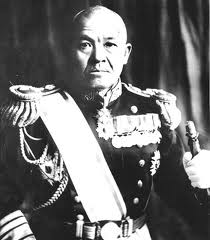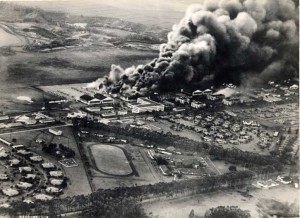- Date: Sunday December 7th 1941
- Location: United States Naval Base (Pearl Harbour), Hawaii
- Party’s Involved: Empire of Japan vs. United States
Key Figures for the United States
Husband Edward Kimmel: Four Star Admiral in The United States Navy
- He served as commander-in-chief, of the U.S. Pacific Fleet during the Pearl Harbour Attack.
- Because of the attack, he was removed from his post and reduced to the position of two-star rank of rear admiral.
Walter Campbell Short: U.S. Military Commander
- Responsible for the defence of U.S. military installations in Hawaii during the time of the Japanese attack on Pearl Harbour.
- Both Short and Kimmel were accused of being unprepared and charged with dereliction of duty by the Roberts Commission
Key Figures for the Empire of Japan
Chuichi Nagumo: Admiral in the Imperial Japanese Navy
- He was a strong supporter for the combination of sea and air power but was opposed to Admiral Isoroku Yamamoto’s plan to attack Pearl Harbour
- Commander of the First Air Fleet during the attack and was criticized for his failure to launch a third attack, which might have destroyed the fuel oil storage and repair facilities. This would have rendered the most important American naval base in the Pacific useless.
- Also criticized for not destroying the submarine base and intelligence station in the harbour. Interestingly enough, it was these two areas of the base that were the determining factors of US Naval supremacy and Japanese defeat.
Isoroku Yamamoto: Commander in-chief of the Imperial Japanese Navy and the Carrier Striking Task Force
- Was responsible for the planning and organization of the Pearl Harbour Raid.
- According to the parameters of the mission established by Yamamoto the attack was a success. His goal was to sink at least four US battleships and prevent the U.S. Fleet from subverting Japans imperialistic aims for at least six months.
Historical Context: A Japanese Perspective
- Japanese antagonism towards the United States were initiated as a result of the Depression
- Following the Stock Market Crash of 1929, Japanese disillusion with part government grew and through a series of internal rebellions, a militant party soon replaced the moderates
- In January of 1931, Japan occupied Manchuria, and as Japanese belligerency increased, their relations with the United States deteriorated
- Japanese occupation of Manchuria was essential to their supremacy as they needed Northern China’s natural resources to improve their heavy and light industries.
- Additionally, the mentality of racial superiority led Japan to believe that they deserved to dominate Asian politics.
- Bruce Robinson ” As with Nazi Germany and Fascist Italy, this combination bred an aggressive and neo-colonial foreign policy, the ‘Greater East Asia Co-prosperity Sphere”.
Historical Context: An American Perspective
- Alarmed by Japanese aggression, American ended their commercial treaty on January 1940, that had lasted for 29 years
- In July of the same year, the US placed an embargo on scrap iron and aviation fuel
- Relations deteriorated further when Japan in September of 1940 signed the Tripartite Pact with Germany and Italy. This signified Japan’s declaration as a formal member of the Axis powers.
- This conflicted greatly with the US as although they had adopted a isolationist stance it was still clear that American sympathies were aligned the Allies.
- Bruce Robinson “President Franklin D. Roosevelt had already strained the sinews of neutrality by supplying Britain with money and arms under the ‘lend-lease’ agreement”.
- The treaty signified that any supplies sent to Japan by the Americans would indirectly be aiding Italy and Germany; further embargoes were the American response to the Japanese stance.
- Japans survival was under threat and as a result they increased their search for a permanent alternative for natural resources.
- The most obvious target was South-east Asia, a region that was rich in minerals and oil. However, Japan knew that a full scale invasion of this region would prompt war with the US
The Attack
- By destroying the Pacific Fleet, Japan aimed to remove America as a threat long enough for them to secure the resources they needed. Additionally, they hoped that they would crush American morale sufficiently to prompt FDR to sue for peace.
- At 7:55 am, on Sunday December 7th 1941, the first two waves of Japanese aircraft began their attack
- Within two hours, five battleships had been sunk another 16 large vessels damaged and 188 aircrafts destroyed.
- In the first 15 minutes of the attack close to 2/3 of the causality numbers had been achieved
- Bruce Robinson, “Operationally brilliant, the attack was strategically disastrous”.
Winner: Empire of Japan
American Causalities after Pearl Harbour
- 4 Battleships sunk

- 4 Battleships damaged, including 1 run aground
- 2 Destroyers sunk, 1 damaged
- 3 Cruisers damaged
- 188 Aircrafts destroyed
- 155 Aircrafts damaged
- 2,403 Casualties
- 68 Civilians killed
- 1178 Civilians wounded
Japanese Casualties after Pearl Harbour
- 4 Midget submarines sunk
- 1 Midget submarine run aground
- 27 Aircrafts destroyed
- 55 Airmen killed
- 9 Submariners killed
- 1 Submariner captured
Bibliography
Robinson, Bruce. “World Wars In Depth.” 24/11/09.http://www.bbc.co.uk/history/worldwars/wwtwo/ (accessed 01/12/09).

What was the importance of this attack, historically?